4#厂房土建及钢结构工程量清单预算
新世纪大学英语综合教程4第四册Unit 4
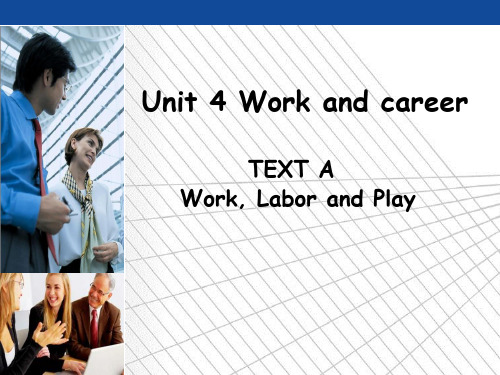
Brainstorming
Directions: What words will occur to you whenever we mention the phrase “choosing a career”. Write down as many words as possible about it.
Operating engineers
Global reading
1 Structure Analysis
2
Table Completion
3
True or False
Structure Analysis
Parts Paras. Main Ideas
The author explains his understanding of work, labor, and play. Whether one is a laborer or a 1~3 worker has little to do with whether he or she is doing a physical or a mental job, but with the attitude he or she takes towards the job he or she does.
1
2
4
In the author’s eyes, the majority of people in a modern technological society are laborers rather than workers. The author stresses the two negative aspects of technology and the division of labor: by eliminating the need for special skills, they turned enjoyable work into boring labor and by increasing productivity, they give people excessive leisure time.
全新版大学英语综合教程4课后翻译(完整版)
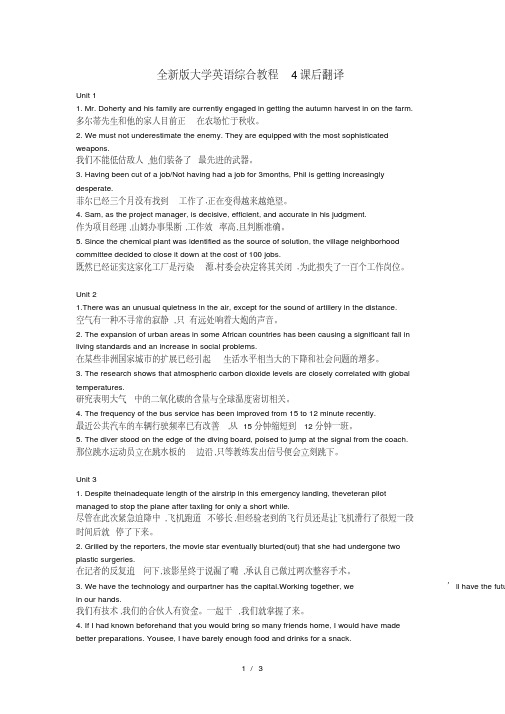
全新版大学英语综合教程4课后翻译Unit 11. Mr. Doherty and his family are currently engaged in getting the autumn harvest in on the farm.多尔蒂先生和他的家人目前正在农场忙于秋收。
2. We must not underestimate the enemy. They are equipped with the most sophisticatedweapons.我们不能低估敌人,他们装备了最先进的武器。
3. Having been cut of a job/Not having had a job for 3months, Phil is getting increasinglydesperate.菲尔已经三个月没有找到工作了,正在变得越来越绝望。
4. Sam, as the project manager, is decisive, efficient, and accurate in his judgment.作为项目经理,山姆办事果断,工作效率高,且判断准确。
5. Since the chemical plant was identified as the source of solution, the village neighborhoodcommittee decided to close it down at the cost of 100 jobs.既然已经证实这家化工厂是污染源,村委会决定将其关闭,为此损失了一百个工作岗位。
Unit 21.There was an unusual quietness in the air, except for the sound of artillery in the distance.空气有一种不寻常的寂静,只有远处响着大炮的声音。
2. The expansion of urban areas in some African countries has been causing a significant fall inliving standards and an increase in social problems.在某些非洲国家城市的扩展已经引起生活水平相当大的下降和社会问题的增多。
幼儿园数字4的正确写法

《幼儿园数字 4 的正确写法》
亲爱的小朋友们,今天老师要和大家一起学习数字 4 的正确写法哦。
小朋友们,咱们先来看看数字 4 像什么呀?它呀,有点像小旗子在飘呢。
写数字 4 的时候,咱们要先准备好小铅笔和小本子。
第一步,先在本子上轻轻地画一个小斜线,就像滑梯一样,从左上慢慢滑到右下。
老师给大家讲个小故事吧。
有一天,小猴子去游乐场玩滑梯,它从高高的地方一下子就滑了下来,可开心啦!咱们写数字 4 的这第一步,就像小猴子滑滑梯。
接下来,再画一个竖线,要直直的,像小竹子一样。
然后呀,再画一个小斜线,从右上滑到左下。
最后,把下面封上口,数字 4 就写好啦!
小朋友们看,写好的数字 4 是不是很漂亮呀?
老师再给大家举个例子。
比如说,咱们有 4 个小苹果,就可以用数字 4 来表示。
小朋友们可以一边念着“小滑梯,小竹子,再滑一下封上口”,一边写数字 4 。
咱们班的小明小朋友,一开始写数字 4 总是写不好,但是他不放弃,每天都认真练习,现在写得可漂亮啦!
小朋友们,咱们多练习几次,一定能把数字 4 写得又好看又正确。
等大家都学会写数字 4 了,老师会给大家奖励小贴画哟!
加油,小朋友们,相信你们都能写好数字 4 !。
Unit 4 词法翻译 - 增词法和省词法

Unit 4. Translation Techniques of Words and Expressions 词法翻译(2)Outline of this unit1. Addition 增词法2. Omission 省词法1. Addition 增词法增补翻译是在原文的基础上,增加一些词语,使译文的语法结构、修辞方式及语言表达符合汉语的行文要求。
要点:增词不增义,增加原文中已省略但汉语表达所需要的词语,不能随心所欲地增加。
增词法的主要类型:语法方面:动词、量词、时态词、名词修辞方面:名词复数、语气词逻辑方面:表示概括性、承上启下、逻辑关联的词语语法方面:动词、量词、时态词、名词上述这些词汇在英语语法中省略了,但在汉语中不可或缺,译文中要增加。
动词:英语动词呈显性;汉语动词在句中是表意的重心,不可少,并且汉语动词不受形态的约束,运用极为灵活,在汉语中备受青睐。
I fell madly in love with her, and she with me.Histories make men wise, poets witty, the mathematics subtle, natural philosophy deep, moral grave, logic and rhetoric able to contend.After the football match, he’s got an important meeting.He dismissed the meeting without a closing speech.练习:I am looking forward to the holidays.We won’t retreat, we never have and never will.Reading makes a full man; conference a ready man; and writing an exact man.The world needn’t be afraid of a possible shortage of coal, oil, natural gas or other sources of fuel for the future.接下来看增加量词的情况。
4的数字代表什么意思有什么含义

4的数字代表什么意思有什么含义 在中国民间,许多⼈都因“四”与“死”的发⾳相近,⾯对“四”有所忌讳,和西⽅社会对“⼗三”的忌讳是类似的。
那么,你知道4的数字代表什么意思吗?接下来就跟着店铺⼀起去看看数字4的含义吧。
数字4的含义(⼀) 数字4的含义:执⾏数 数字四代表物质的坚固性,也就是物质的组成和建造。
⼀个坚固的物质或实体,是它众多构成体的整体组合,同时它⾃⼰⼜是⼆个新的整体。
绝对的⼀以数字四来定义⾃⼰,因爲他同时是⼀个整体和所有构成体(创造)的组合。
埃及⼈运⽤四个简单的现象(⽕、风、⼟、⽔)来形容构成物质所必需的四元素的作⽤⾓⾊。
⽕是活跃的,凝结的法则;⼟是接收的、格式化的法则,风是细微的、沉思的法则,会影响⼒量的交换;⽔是总和,是⼈、⼟、⽔的组合法则,⽔也是⼀种在它们之上的物质。
数字4总是呈现出苦难的特质,它代表着⽣命中那些让你感觉受限、需要收敛⾃我的⽅⾯。
⾯对种种困难应该采取怎样的解决之道,我们在⾯对逆境的时⼜应当如何规范⾃⼰的⼯作⽣活,都需要极强的组织思维与⾃律性,数字4便是带给我们这样的⼈⽣课题。
数字4的含义(⼆) 关键词:限制、规范、服务 象征符号:四⽅型 属性:计算智商型 对应⾊彩;绿⾊ 五⾏:阴⽕ 星座排⾏:巨蟹 这个数字在形态上就像⼀把三⾓量尺,代表精算,中规中矩,同时每⼀笔都是直挺的,见棱见⾓,象征着死板,不知变通。
四季分春夏秋冬,⽅向分东南西北,物质存在的四元素分为⽕、⽔、风、地,数字4代表了完整的秩序。
数字4的物质平⾯结构就像⼀个正⽅盒⼦,坚固、完善、安全。
数字本质都带有原始的意义,1和2的结合创造了3,当组合成⼀个家庭时,就要靠数字4来稳定⽣存的基本“安全”,4的任务就是实现和显化。
正⾯优势 帮助他⼈,实际,秩序,效率,⾃律,组织⼒,可靠,实⼲,诚恳,有勇⽓,任劳任怨,未⾬绸缪,稳重,做事认真,坚定,忠实,逻辑分明 负⾯挑战 ⼼胸狭隘,情绪紧张,不妥协,过分固执,过于谨慎,约束,拒绝改变,⾃我保护,挑剔,嫉妒⼼,吝啬,⼼胸狭窄,缺乏想象⼒,说教,不变通,⽆趣乏味 恐惧 变化,不稳定,⽣活危机 数字4的含义(三) 起初,⼈们都认为“四”最⼀般的象征含义是四⽅和四时。
阅读教程一Unit 4
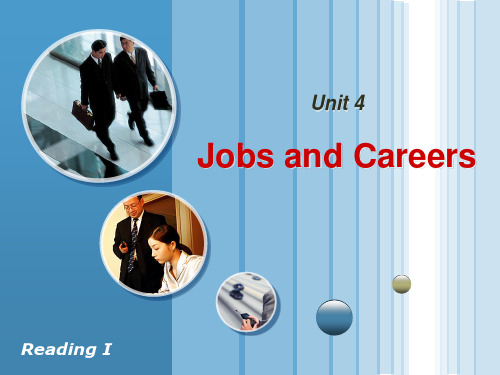
number of people are not satisfied with their jobs.
___F___ 4. In the author’s opinion, many things have to be
• The conversation would lull for a while.
平静,安静; 平息
lull n. 暂停; 间歇;平静期
• a lull in the fighting / political violence /
conversation / storm
Para. 10
dull adj.
What would you do if you take a job you don’t like? Give reasons to support your idea.
Reading One – Enjoy Your Job
Style of Writing
• Argumentation
Structure
Para. 10
dull adj.
• The coffin closed with a dull thud.
• (声音)不清晰的,隐约的,低沉的
• The pain, usually a dull ache, gets
worse with exercise. • (感觉)不明显的,不强烈的,隐约的
Reading One – Enjoy Your Job
Para. 3 apt adj.
• an apt remark / description / choice
《使命召唤4:现代战争》全流程全收集图文攻略

《使命召唤4:现代战争》全流程全收集图⽂攻略 情报收集1 打开船舱进⼊后,跟着⼩队下楼。
你会在下层舱室看到⼀个醉⿁敌⼈。
就在醉⿁旁边舱室的桌⾯上。
%{p a g e-b r e a k|情报收集1|p a g e-b r e a k}% 情报收集2 船底⼤货仓。
货仓地⾯的栅格⽹上。
%{p a g e-b r e a k|情报收集2|p a g e-b r e a k}% 情报收集3 跟随队友前进时,遇到有敌⼈的路边棚屋。
消灭掉棚屋内的敌⼈。
情报在桌⾯上。
%{p a g e-b r e a k|情报收集3|p a g e-b r e a k}% 情报收集4 灰⽩⾊⽼旧建筑。
进⼊后带上夜视仪,上楼。
楼上房间,马桶旁的桌⼦上。
%{p a g e-b r e a k|情报收集4|p a g e-b r e a k}% 情报收集5 开始时队友在外警戒的临时基地。
下楼进⼊地下室。
地下室⼤厅旁的⼩房间,有3个拳头海报的桌⼦上。
%{p a g e-b r e a k|情报收集5|p a g e-b r e a k}% 情报收集6 巷战,有⽔塔的街道。
前进经过⽔塔后向右转。
⾓落房间⼆楼的桌⼦上。
%{p a g e-b r e a k|情报收集6|p a g e-b r e a k}% 情报收集7 从刚才的房间出去。
向有多个卫星接收器(锅盖)的建筑⽅向⾛。
从蓝⾊的废弃车辆和有3个拳头海报的楼梯⼜上去。
情报就在露台上的桌⼦上。
%{p a g e-b r e a k|情报收集7|p a g e-b r e a k}% 情报收集8 夜视夜战的⼤楼。
⼆楼时会有⼀个等待队友破门⽽⼊的房间。
进去后会看到强光,取下夜视镜就能发现情报。
%{p a g e-b r e a k|情报收集8|p a g e-b r e a k}% 情报收集9 巷战街道,在有⾃⾏车的⾓落右转。
连续右转前进,知道看到有⾹蕉、⽔果箱⼦在前⾯的建筑。
计量经济学第4章课后答案

17CHAPTER 4SOLUTIONS TO PROBLEMS4.2 (i) and (iii) generally cause the t statistics not to have a t distribution under H 0.Homoskedasticity is one of the CLM assumptions. An important omitted variable violates Assumption MLR.3. The CLM assumptions contain no mention of the sample correlations among independent variables, except to rule out the case where the correlation is one.4.3 (i) While the standard error on hrsemp has not changed, the magnitude of the coefficient has increased by half. The t statistic on hrsemp has gone from about –1.47 to –2.21, so now the coefficient is statistically less than zero at the 5% level. (From Table G.2 the 5% critical value with 40 df is –1.684. The 1% critical value is –2.423, so the p -value is between .01 and .05.)(ii) If we add and subtract 2βlog(employ ) from the right-hand-side and collect terms, we havelog(scrap ) = 0β + 1βhrsemp + [2βlog(sales) – 2βlog(employ )] + [2βlog(employ ) + 3βlog(employ )] + u = 0β + 1βhrsemp + 2βlog(sales /employ ) + (2β + 3β)log(employ ) + u ,where the second equality follows from the fact that log(sales /employ ) = log(sales ) – log(employ ). Defining 3θ ≡ 2β + 3β gives the result.(iii) No. We are interested in the coefficient on log(employ ), which has a t statistic of .2, which is very small. Therefore, we conclude that the size of the firm, as measured by employees, does not matter, once we control for training and sales per employee (in a logarithmic functional form).(iv) The null hypothesis in the model from part (ii) is H 0:2β = –1. The t statistic is [–.951 – (–1)]/.37 = (1 – .951)/.37 ≈ .132; this is very small, and we fail to reject whether we specify a one- or two-sided alternative.4.4 (i) In columns (2) and (3), the coefficient on profmarg is actually negative, although its t statistic is only about –1. It appears that, once firm sales and market value have been controlled for, profit margin has no effect on CEO salary.(ii) We use column (3), which controls for the most factors affecting salary. The t statistic on log(mktval ) is about 2.05, which is just significant at the 5% level against a two-sided alternative.18(We can use the standard normal critical value, 1.96.) So log(mktval ) is statistically significant. Because the coefficient is an elasticity, a ceteris paribus 10% increase in market value is predicted to increase salary by 1%. This is not a huge effect, but it is not negligible, either.(iii) These variables are individually significant at low significance levels, with t ceoten ≈ 3.11 and t comten ≈ –2.79. Other factors fixed, another year as CEO with the company increases salary by about 1.71%. On the other hand, another year with the company, but not as CEO, lowers salary by about .92%. This second finding at first seems surprising, but could be related to the “superstar” effect: firms that hire CEOs from outside the company often go after a small pool of highly regarded candidates, and salaries of these people are bid up. More non-CEO years with a company makes it less likely the person was hired as an outside superstar.4.7 (i) .412 ± 1.96(.094), or about .228 to .596.(ii) No, because the value .4 is well inside the 95% CI.(iii) Yes, because 1 is well outside the 95% CI.4.8 (i) With df = 706 – 4 = 702, we use the standard normal critical value (df = ∞ in Table G.2), which is 1.96 for a two-tailed test at the 5% level. Now t educ = −11.13/5.88 ≈ −1.89, so |t educ | = 1.89 < 1.96, and we fail to reject H 0: educ β = 0 at the 5% level. Also, t age ≈ 1.52, so age is also statistically insignificant at the 5% level.(ii) We need to compute the R -squared form of the F statistic for joint significance. But F = [(.113 − .103)/(1 − .113)](702/2) ≈ 3.96. The 5% critical value in the F 2,702 distribution can be obtained from Table G.3b with denominator df = ∞: cv = 3.00. Therefore, educ and age are jointly significant at the 5% level (3.96 > 3.00). In fact, the p -value is about .019, and so educ and age are jointly significant at the 2% level.(iii) Not really. These variables are jointly significant, but including them only changes the coefficient on totwrk from –.151 to –.148.(iv) The standard t and F statistics that we used assume homoskedasticity, in addition to the other CLM assumptions. If there is heteroskedasticity in the equation, the tests are no longer valid.4.11 (i) Holding profmarg fixed, n rdintensΔ = .321 Δlog(sales ) = (.321/100)[100log()sales ⋅Δ] ≈ .00321(%Δsales ). Therefore, if %Δsales = 10, n rdintens Δ ≈ .032, or only about 3/100 of a percentage point. For such a large percentage increase in sales,this seems like a practically small effect.(ii) H 0:1β = 0 versus H 1:1β > 0, where 1β is the population slope on log(sales ). The t statistic is .321/.216 ≈ 1.486. The 5% critical value for a one-tailed test, with df = 32 – 3 = 29, is obtained from Table G.2 as 1.699; so we cannot reject H 0 at the 5% level. But the 10% criticalvalue is 1.311; since the t statistic is above this value, we reject H0 in favor of H1 at the 10% level.(iii) Not really. Its t statistic is only 1.087, which is well below even the 10% critical value for a one-tailed test.1920SOLUTIONS TO COMPUTER EXERCISESC4.1 (i) Holding other factors fixed,111log()(/100)[100log()](/100)(%),voteA expendA expendA expendA βββΔ=Δ=⋅Δ≈Δwhere we use the fact that 100log()expendA ⋅Δ ≈ %expendA Δ. So 1β/100 is the (ceteris paribus) percentage point change in voteA when expendA increases by one percent.(ii) The null hypothesis is H 0: 2β = –1β, which means a z% increase in expenditure by A and a z% increase in expenditure by B leaves voteA unchanged. We can equivalently write H 0: 1β + 2β = 0.(iii) The estimated equation (with standard errors in parentheses below estimates) isn voteA = 45.08 + 6.083 log(expendA ) – 6.615 log(expendB ) + .152 prtystrA(3.93) (0.382) (0.379) (.062) n = 173, R 2 = .793.The coefficient on log(expendA ) is very significant (t statistic ≈ 15.92), as is the coefficient on log(expendB ) (t statistic ≈ –17.45). The estimates imply that a 10% ceteris paribus increase in spending by candidate A increases the predicted share of the vote going to A by about .61percentage points. [Recall that, holding other factors fixed, n voteAΔ≈(6.083/100)%ΔexpendA ).] Similarly, a 10% ceteris paribus increase in spending by B reduces n voteAby about .66 percentage points. These effects certainly cannot be ignored.While the coefficients on log(expendA ) and log(expendB ) are of similar magnitudes (andopposite in sign, as we expect), we do not have the standard error of 1ˆβ + 2ˆβ, which is what we would need to test the hypothesis from part (ii).(iv) Write 1θ = 1β +2β, or 1β = 1θ– 2β. Plugging this into the original equation, and rearranging, givesn voteA = 0β + 1θlog(expendA ) + 2β[log(expendB ) – log(expendA )] +3βprtystrA + u ,When we estimate this equation we obtain 1θ≈ –.532 and se( 1θ)≈ .533. The t statistic for the hypothesis in part (ii) is –.532/.533 ≈ –1. Therefore, we fail to reject H 0: 2β = –1β.21C4.3 (i) The estimated model isn log()price = 11.67 + .000379 sqrft + .0289 bdrms (0.10) (.000043) (.0296)n = 88, R 2 = .588.Therefore, 1ˆθ= 150(.000379) + .0289 = .0858, which means that an additional 150 square foot bedroom increases the predicted price by about 8.6%.(ii) 2β= 1θ – 1501β, and solog(price ) = 0β+ 1βsqrft + (1θ – 1501β)bdrms + u= 0β+ 1β(sqrft – 150 bdrms ) + 1θbdrms + u .(iii) From part (ii), we run the regressionlog(price ) on (sqrft – 150 bdrms ), bdrms ,and obtain the standard error on bdrms . We already know that 1ˆθ= .0858; now we also getse(1ˆθ) = .0268. The 95% confidence interval reported by my software package is .0326 to .1390(or about 3.3% to 13.9%).C4.5 (i) If we drop rbisyr the estimated equation becomesn log()salary = 11.02 + .0677 years + .0158 gamesyr (0.27) (.0121) (.0016)+ .0014 bavg + .0359 hrunsyr (.0011) (.0072)n = 353, R 2= .625.Now hrunsyr is very statistically significant (t statistic ≈ 4.99), and its coefficient has increased by about two and one-half times.(ii) The equation with runsyr , fldperc , and sbasesyr added is22n log()salary = 10.41 + .0700 years + .0079 gamesyr(2.00) (.0120) (.0027)+ .00053 bavg + .0232 hrunsyr (.00110) (.0086)+ .0174 runsyr + .0010 fldperc – .0064 sbasesyr (.0051) (.0020) (.0052) n = 353, R 2 = .639.Of the three additional independent variables, only runsyr is statistically significant (t statistic = .0174/.0051 ≈ 3.41). The estimate implies that one more run per year, other factors fixed,increases predicted salary by about 1.74%, a substantial increase. The stolen bases variable even has the “wrong” sign with a t statistic of about –1.23, while fldperc has a t statistic of only .5. Most major league baseball players are pretty good fielders; in fact, the smallest fldperc is 800 (which means .800). With relatively little variation in fldperc , it is perhaps not surprising that its effect is hard to estimate.(iii) From their t statistics, bavg , fldperc , and sbasesyr are individually insignificant. The F statistic for their joint significance (with 3 and 345 df ) is about .69 with p -value ≈ .56. Therefore, these variables are jointly very insignificant.C4.7 (i) The minimum value is 0, the maximum is 99, and the average is about 56.16. (ii) When phsrank is added to (4.26), we get the following:n log() wage = 1.459 − .0093 jc + .0755 totcoll + .0049 exper + .00030 phsrank (0.024) (.0070) (.0026) (.0002) (.00024)n = 6,763, R 2 = .223So phsrank has a t statistic equal to only 1.25; it is not statistically significant. If we increase phsrank by 10, log(wage ) is predicted to increase by (.0003)10 = .003. This implies a .3% increase in wage , which seems a modest increase given a 10 percentage point increase in phsrank . (However, the sample standard deviation of phsrank is about 24.)(iii) Adding phsrank makes the t statistic on jc even smaller in absolute value, about 1.33, but the coefficient magnitude is similar to (4.26). Therefore, the base point remains unchanged: the return to a junior college is estimated to be somewhat smaller, but the difference is not significant and standard significant levels.(iv) The variable id is just a worker identification number, which should be randomly assigned (at least roughly). Therefore, id should not be correlated with any variable in the regression equation. It should be insignificant when added to (4.17) or (4.26). In fact, its t statistic is about .54.23C4.9 (i) The results from the OLS regression, with standard errors in parentheses, aren log() psoda =−1.46 + .073 prpblck + .137 log(income ) + .380 prppov (0.29) (.031) (.027) (.133)n = 401, R 2 = .087The p -value for testing H 0: 10β= against the two-sided alternative is about .018, so that we reject H 0 at the 5% level but not at the 1% level.(ii) The correlation is about −.84, indicating a strong degree of multicollinearity. Yet eachcoefficient is very statistically significant: the t statistic for log()ˆincome β is about 5.1 and that forˆprppovβ is about 2.86 (two-sided p -value = .004).(iii) The OLS regression results when log(hseval ) is added aren log() psoda =−.84 + .098 prpblck − .053 log(income ) (.29) (.029) (.038) + .052 prppov + .121 log(hseval ) (.134) (.018)n = 401, R 2 = .184The coefficient on log(hseval ) is an elasticity: a one percent increase in housing value, holding the other variables fixed, increases the predicted price by about .12 percent. The two-sided p -value is zero to three decimal places.(iv) Adding log(hseval ) makes log(income ) and prppov individually insignificant (at even the 15% significance level against a two-sided alternative for log(income ), and prppov is does not have a t statistic even close to one in absolute value). Nevertheless, they are jointly significant at the 5% level because the outcome of the F 2,396 statistic is about 3.52 with p -value = .030. All of the control variables – log(income ), prppov , and log(hseval ) – are highly correlated, so it is not surprising that some are individually insignificant.(v) Because the regression in (iii) contains the most controls, log(hseval ) is individually significant, and log(income ) and prppov are jointly significant, (iii) seems the most reliable. It holds fixed three measure of income and affluence. Therefore, a reasonable estimate is that if the proportion of blacks increases by .10, psoda is estimated to increase by 1%, other factors held fixed.。
WTZ-4使用说明

2.3具有工作状态显示功能及自检结果调用显示功能。
2.4具有单工同/异频功能。
2.5具有长发保护功能。
3
主机架一台
控制盒(仅车站台、遥控台配置)一只
控制盒连接电缆(仅车站台、遥控台配置)一根
车站台至天线间馈线(长度见合同)一根
天线(全向或定向)一付
区间台由电台、电源、遥控盘、主控盘及有线防雷配线板组成。不配置车站控制盒,区间台受遥控台控制。
车站台由电台、电源、主控盘、有线盘(根据用户需要选配)、有线防雷配线板及车站控制盒组成。
由于主机各部分形成单盘化,因此维修方便。
2
2.1区间台具有交/直流电源自动切换功能。当远供停电时,自动转换到预先接通的电池组上。
ON (1)
5频组
457.925 MHz
ON (1)
OFF(0)
OFF(0)
6频组
458.000 MHz
ON (1)
OFF(0)
ON (1)
7频组
458.200 MHz
ON (1)
ON (1)
OFF(0)
8频组
458.250 MHz
ON (1)
ON (1)
ON (1)
测试操作方法及显示简表
初始状态:控制盒状态灯全亮,其余灯灭。
5.6.3车站值班员拿起手机可以监听调度与司机间通话,握PTT键时可插话。
5.7机车、车站或便携台单工呼入
5.7.1若收到机车台、便携台或相邻站台呼叫本车站台的信令时,则站台进入单工通信状态,呼叫信令消失,站台自动发射0.5秒回铃音,同时控制盒上“同频司机”键和“同频车站”键的红色指示灯亮,车站台置为接收状态,可从控制盒喇叭中接收呼叫话音,如果8秒内不摘机,则指示灯熄灭,车站台回到守候状态。
数字4的风水含义是什么

数字4的风水含义是什么
【数字4的风水含义】
1、阴阳平衡:数字4可以把阴阳的力量平衡起来,表示着阴与阳的不
断变化和互相补充,象征和谐、长寿、统一。
2、造型象征:数字4有“方正”之美,比喻调和之美,可以应用到建筑、装饰、摆设等方面,给人以宽广、充满、安全的感觉。
3、古德耆境:数字4与中国传统哲学的“道德耆境”有着巨大的关联,
反映了四季的到来,以及极乐世界和宇宙的起源、互动和演化。
4、五行关联:数字4有着与五行关联的含义,阳有着土、金、水、火,而阴有木,这五者是相互结合、彼此促进的,象征着新的生命和宁静。
5、四象传承:数字4和“四象”有着深刻的联系,象征着永恒不变、四
季之秀、平和宽容,在整个宇宙体系里具有根本的纽带作用。
6、吉祥意义:数字4代表吉祥、繁荣、和平,可以用在室内、家居装
饰上,把不同的物质与精神元素完美结合,给人以喜乐,祝愿团圆,
家庭团聚。
7、合圆卦象:数字4与家庭组织的卦象有着重要的相关性,象征着图
腾的复合性和社会的维系。
可以把它用在书画、香梯、摆件等上,预
示着一家人和睦、完满相处。
上海外语教育出版社大学英语听说教程4听力原文
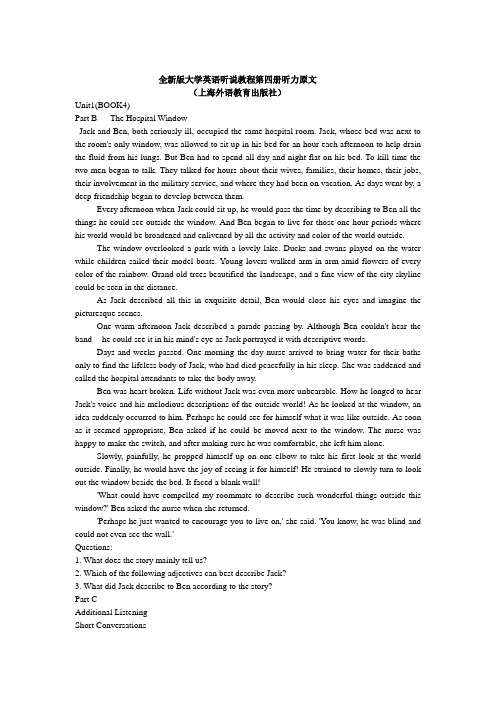
全新版大学英语听说教程第四册听力原文(上海外语教育出版社)Unit1(BOOK4)Part B The Hospital WindowJack and Ben, both seriously ill, occupied the same hospital room. Jack, whose bed was next to the room's only window, was allowed to sit up in his bed for an hour each afternoon to help drain the fluid from his lungs. But Ben had to spend all day and night flat on his bed. To kill time the two men began to talk. They talked for hours about their wives, families, their homes, their jobs, their involvement in the military service, and where they had been on vacation. As days went by, a deep friendship began to develop between them.Every afternoon when Jack could sit up, he would pass the time by describing to Ben all the things he could see outside the window. And Ben began to live for those one-hour periods where his world would be broadened and enlivened by all the activity and color of the world outside.The window overlooked a park with a lovely lake. Ducks and swans played on the water while children sailed their model boats. Young lovers walked arm in arm amid flowers of every color of the rainbow. Grand old trees beautified the landscape, and a fine view of the city skyline could be seen in the distance.As Jack described all this in exquisite detail, Ben would close his eyes and imagine the picturesque scenes.One warm afternoon Jack described a parade passing by. Although Ben couldn't hear the band -- he could see it in his mind's eye as Jack portrayed it with descriptive words.Days and weeks passed. One morning the day nurse arrived to bring water for their baths only to find the lifeless body of Jack, who had died peacefully in his sleep. She was saddened and called the hospital attendants to take the body away.Ben was heart broken. Life without Jack was even more unbearable. How he longed to hear Jack's voice and his melodious descriptions of the outside world! As he looked at the window, an idea suddenly occurred to him. Perhaps he could see for himself what it was like outside. As soon as it seemed appropriate, Ben asked if he could be moved next to the window. The nurse was happy to make the switch, and after making sure he was comfortable, she left him alone.Slowly, painfully, he propped himself up on one elbow to take his first look at the world outside. Finally, he would have the joy of seeing it for himself! He strained to slowly turn to look out the window beside the bed. It faced a blank wall!'What could have compelled my roommate to describe such wonderful things outside this window?' Ben asked the nurse when she returned.'Perhaps he just wanted to encourage you to live on,' she said. 'You know, he was blind and could not even see the wall.'Questions:1. What does the story mainly tell us?2. Which of the following adjectives can best describe Jack?3. What did Jack describe to Ben according to the story?Part CAdditional ListeningShort ConversationsConversation 1:M: How do you like your roommate, Debby?W: Ever since we met on the first day of college, we've been inseparable.Q: What do you know about Debby and her roommate?Conversation 2:M: Have you heard from Linda lately? You two were so intimate in college.W: Well, honestly, I haven't heard from her as much as I used to since she moved to the east coast two months ago. But I'm sure the friendship between us is as strong as it was before.Q: What can you infer from the woman’s response?Conversation 3:W: Do you keep in touch with your old friends back home now that you don't see them regularly? M: Frankly, after I moved to this city, I'm out of touch with most of them except a few close ones. Q: What does the man mean?Conversation 4:W: It's polite to call a friend before we visit, isn't it?M: You're right. People usually don't like surprise visits. But close friends often drop in on each other.Q: What does the man mean?Conversation 5:M: Cathy, it seems that you and Sally do almost everything together.W: That's true. You see, we were born on the same day. We both majored in fashion designing. And we even have the same love for using bright-colored material in our designs. Isn't it amazing! Q: What can we learn from the conversation?Part DThe Colors of FriendshipLegend has it that the colors of the world started to quarrel one day. All claimed that they were the best, the most beautiful.Green said: "Clearly I am the most important. I am the sign of life and of hope. I was chosen for grass, trees and leaves. Without me, all animals would die."Blue interrupted: "You only think about the earth, but have you ever considered the color of the sky and the sea?"Hearing this, Yellow chuckled: "You are all so serious. I bring laughter, gaiety and warmth into the world. I am the color of the sun, the moon and all the stars. Without me there would be no fun."Orange started next to blow her trumpet: "I am the color of health and strength. I may be scarce, but I am precious, for I serve the needs of human life."At this, Red could stand it no longer. He shouted: "I am the ruler of all of you. I am the color of blood -- life's blood! I am also the color of danger and bravery, of passion and love."Purple rose up to his full height: "I am the color of royalty and power. I am the sign of authority and wisdom. People do not question me! They listen and obey."Finally Indigo spoke: "Think of me. I am the color of silence. You hardly notice me, but without me you all become superficial. I represent thought and reflection."And so the colors went on boasting. Their quarrelling became louder and louder. Suddenly there was a startling flash of bright lightning, followed by a roll of thunder. Rain started to pourdown. The colors crouched down in fear, drawing close to one another for comfort.Just then rain began to speak: "You foolish colors, fighting amongst yourselves, each trying to dominate the rest. Don't you know that you were each made for a special purpose, unique and different? Join hands with one another and come to me."Doing as they were told, the colors united and joined hands.Then rain continued: "From now on, when it rains, each of you will stretch across the sky to form a great bow of colors as a reminder that you can all live in peace. The rainbow is a sign of hope for tomorrow."And so, whenever a good rain washes the world, a rainbow appears in the sky, to let us remember to appreciate one another.Unit 2Part BEmbarrassing Experiences (Part One)Interviewer: Rob, you went to Brazil, didn't you?Rob: Yes, I did.Interviewer: So, what happened?Rob: Well, I went into this meeting and there were about, er... seven or eight people in there and I just said 'Hello' to everybody and sat down. Apparently, what I should have done is to go round the room shaking hands with everyone individually. Well, you know, it's silly of me because I found out later it upset everyone. I mean, I think they felt I was taking them for granted.Kate: Well, I know that because when I was in France the first time, I finished a meeting , with 'Goodbye, everyone!' to all the people in the room. There were about half a dozen people there but I was in a hurry to leave, so I just said that and left. Well, I later found out that what I should have done is shake hands with everyone in the group before leaving. Now, apparently, it's the polite thing to do.Interviewer: Well, people shake hands in different ways, don't they?Rob: Oh, yes, that's right, they do. See, normally I shake hands quite gently when I meet someone. So when I went to the US for the first time, I think people there thought my weak handshake was a sign of weakness. Apparently, people there tend to shake hands quite firmly.Kate: Oh, gosh, you know, that reminds me: on my first trip to Germany, it was a long time ago, I was introduced to the boss in the company when he passed us in the corridor. Well, I wasn't prepared, and I mean, I had my left hand in my pocket. And when we shook hands I realized my left hand was still in my pocket. Well, that was, you know, very bad manners and I was quite embarrassed.Interviewer: And how about using first names? Have you made any mistakes there?Rob: Oh, yes, I have! When I first went to Italy I thought it was OK to use everyone's first name so as to seem friendly. And I later discovered that in business you shouldn't use someone's first name unless you are invited to. Oh, and you should always use their title as well.Kate: Hm, yeah, well, when I met people in Russia, you know, they seemed to be puzzled when I shook hands with them and said 'How do you do?' Well, what they do when they greet a stranger is to say their own names, so I had that all wrong!Rob: Oh, yes, I agree with that. Remembering names is very important.Interviewer: Shall we take a break? When we come back we'll move on to our next topic.Kate & Rob: OK.Questions:1. What is the conversation mainly about?2. Who might be the people Rob and Kate met in various countries?3. What can we infer about Kate and Rob from the conversation?4. Which countries has Kate visited, according to the conversation?5. Which countries has Rob visited, according to the conversation?6. What is the main message that the speakers want to tell us?Part CAdditional ListeningAmerican PartiesAs you would imagine, Americans move about a great deal at parties. At small gatherings they may sit down, but as soon as there are more people than chairs in a room - a little before this point - you will see first one and then another make some excuse to get to his feet to fetch a drink or greet a friend or open a window until soon everyone is standing, moving around, chatting with one group and then another. Sitting becomes static beyond a certain point. We expect people to move about and be "self-starters". It is quite normal for Americans to introduce themselves; they will drift around a room , stopping to talk wherever they like, introducing themselves and their companions. If this happens, you are expected to reply by giving your name and introducing the person with you; then at least the men generally shake hands. Sometimes the women do so as well, but often they merely nod and smile. A man usually shakes a woman's hand only if she extends it. Otherwise he too just nods and greets her.Statements:1. We can't imagine that Americans do not like big parties and they prefer going around at parties.2. At small parties they may sit down, but as more people come, they would stand up and move about.3. The reason why Americans like to stand is that they like the free atmosphere of the party.4. The meaning of "self-starters" is that Americans help themselves to drinks during the parties.5. Americans are more open-minded than British people according to the passage.6. If a woman doesn't extend her hand to a man at the party, he should not shakes hands with the woman.7. The passage shows a unique aspect of American culture.Embarrassing Experiences (Part Two)Interviewer: Let's go on with our talk. What do you think of business cards, Rob?Rob: I found them very useful when I was in Japan not so long ago. Each person can clearly see the other's name and the job title on the card. And I found out that you have to treat business cards with respect. What you've got to do is hold them with both hands and then read them very carefully. What happened to me was the first time I just took a man's card with one hand and put it straight into my pocket.Interviewer: What other advice do you have, Kate?Kate: Well, one time I unintentionally caused some problems when I was in China. Well, I was trying to make a joke when I pretended to criticize my business associate for being late for a meeting. And he was embarrassed, I mean, he was really embarrassed instead of being amused. Now you shouldn't criticize people in China or embarrass them. I mean, you must avoid confrontation. That's for sure!Rob: Oh, I must tell you about the first time I was in Mexico! I have to admit I found it a bit strange when business associates there touched me on the arm and the shoulder. Well, I tried to move away and, of course, they thought I was being very, very unfriendly. Apparently, it's quite usual there for men to touch each other in, you know, in a friendly way. Oh ... oh, and another thing, the first time I went to Korea I thought it was polite not to look someone in the eye too much. The Koreans I met seemed to be staring at me when I spoke, which seemed, you know, a bit odd at first. In Korea, eye contact conveys sincerity and it shows you're paying attention to the speaker.Kate: Oh, well, it seemed strange because you British don't look at each other so much when you're talking to each other. I mean, you look away, you know, most of the time. I found this hard to deal with when I first came to the UK, because people seemed to be embarrassed when I looked at them while they were speaking to me.Interviewer: So what's the thing visitors to Britain should avoid most?Rob: Well, I don't think we're all that sensitive, do you, Kate?Kate: Ohoo, well, I'll tell you, I made a big mistake when I was in Scotland. I found myself referring to the UK as "England" and to the British as "the English". Now, I know that would be just as bad in Wales, I guess.Rob: Yes, it certainly would!Unit 3Part BBirthday Celebrations Around the WorldChairman: Welcome to this special birthday edition of One World. Yes, folks, we've been on the air for exactly one year now, and we thought it would be a nice idea to have a special program dedicated to birthday celebrations around the world. With us in the studio tonight we have Shaheen Hag and Pat Cane, who have a weekly column on birthdays in the Toronto Daily Star. Shaheen: Good evening.Pat: Good evening.Chairman: Shaheen, perhaps we could begin with you. How are birthdays celebrated in India? Shaheen: Well, perhaps we're all assuming that everyone in the world celebrates their birthday. This just isn't the case. Low-income families in India, for instance, simply can't afford any festivities. And most Muslims don't celebrate their birthdays.Pat: I think Shaheen has raised an interesting point here. The Christian church, too, was actively against celebrating birthdays, and in any case most people, until a couple of hundred years ago, couldn't even read and wouldn't have even been able to spot their birthday on a calendar anyway. Shaheen: Of course some Muslims do celebrate their birthdays. In Egypt, Turkey and Indonesia, for example, the rich people invite friends and families around. But not in small villages. Chairman: Here in England your twenty-first used to be the big one. But now it seems to have moved to eighteen. Is that true?Pat: Yes, in most parts of the West eighteen is now the most important birthday. In Finland, for example, eighteen is the age when you can vote, you know, or buy wines, drive a car and so on. But in Japan I think you have to wait till you're twenty before you can smoke or drink. Shaheen: I know in Senegal, which is another Muslim country, girls get to vote at sixteen and boys at eighteen. And in Bangladesh, girls at eighteen and boys at twenty-one.Chairman: That's interesting. I mean is it typical that around the world girls are considered to bemore mature than boys?Shaheen: Yes, I think so, and there are some countries, particularly in South America, which have a big party only for girls. In Mexico and Argentina, for example, they have enormous parties for 15-year-old girls.Pat: You know in Norway they have a great party for anyone who's not married by the time they're thirty. It's kind of embarrassing. I mean you get pepper thrown at you.Chairman: Pepper? Why pepper?Pat: I'm not really sure.Shaheen: So does that mean that on your 29th birthday you can start thinking 'God I better get married'?Pat: Well, I'm not sure how seriously they take it.Chairman: In England we have quite big parties for your fortieth, fiftieth, sixtieth and so on. Pat: Well, in Japan your eighty-eighth is considered ...Chairman: Eighty-eighth?Pat: ... to be the luckiest birthday. Eight is a very lucky number in Japan.Questions:1. What is One World?2. What is the topic of the program?3. What do Shaheen Hag and Pat Cane do?4. Why don't some people in India celebrate their birthdays?5. According to Pat, when did people around the world begin to celebrate their birthdays?6. Why is the eighteenth birthday so important in Finland?7. Why can girls in some countries get to vote at an earlier age than boys?8. Which of the countries mentioned in the text are Muslim countries?Part CAdditional ListeningsOne World One MinuteOne World One Minute is a unique film project that invites participants in every country around the globe to record, simultaneously, one minute of their lives, one minute of our world. Sponsors of this project have chosen 12:48 GMT, September 11th 2002 as the one minute to record. At that moment exactly a year earlier began the terrorist attacks that led to the deaths of more than 2,000 people from over 60 countries. For many this will be a time of remembrance and reflection. And for others this will be an appropriate time for international communication, cooperation and sharing. It will offer them an opportunity to share a moment of their world and their life with others, an opportunity to both talk to and listen to the world, to join with others around the globe and create a truly unique record and experience. This is the idea behind the project One World One Minute.Participants are free to choose what and how to record their One Minute. Some may want to take photographs, some paint or draw pictures, while others may want to write something and record their readings. The material can be submitted to the project organizers in Scotland via e-mail or post within 6 weeks of September 11th. All the material will then be made into a feature-length film, which will capture that One Minute of our existence.The film will explore the rich diversity that is both humanity and our world. It will allow a voice to all people regardless of nationality, religion, race, political viewpoint, gender or age. Therich diversity that is Humanity shall be there for all to see.Participants will not only be kept informed of the progress of the film and the release process but will be invited to actively participate through newsletters and discussion forums.When the film is finished, it will be shown in every country of the world, both in cinemas and on TV. Contributors will be invited to attend the premiere of the film in their respective countries and will receive a full screen credit on the finished production.Statements:1. One World One Minute is a project sponsored by some filmmakers in Hollywood.2. The purpose of the project is to record how people of the world mourn the death of those who lost their lives in New York's World Trade Center.3. Participants may come from different races or nations, have different religious beliefs, and maintain opposite political viewpoints.4. Participants are invited to record one minute of their lives on any given day.5. Participants are encouraged to make short video films to record an important event in their lives.6. The project will offer people from various parts of the world an opportunity to share a moment of their life with others.7. The organizers believe that humanity is represented by the colorful variety of people's life all over the world.8. Participants are required to submit what they have recorded to organizers by e-mail not later than September 11, 2002.9. All the material submitted by the participants will be made into a feature-length film and shown on TV and in cinemas throughout the world.10. The film will become a powerful means to unite people all over the world in the war against terrorism.Part DOne World, Many UniversesOurs is, in many ways, a world without boundaries. Being a citizen of a particular nation is almost as much as being a resident of a particular town or province. Boundaries of class and caste that once shaped societies continue to fade. The freedom of people to move increases gradually with the relaxation of immigration laws in the last century. Many countries have fairly simple requirements for obtaining citizenship and voting rights.In Europe, for example, the European Union's membership has grown to 15 countries and may increase to 21 or more by 2010. It has developed a common body of laws, common policies and practices, and a great deal of cooperation among its members. The adoption of the single currency, the euro, by 12 of its member countries and the circulation of euro cash in January 2002 have enabled citizens in these countries to move about even more freely.In addition, all of the major organized religions, including Christianity, Judaism, Buddhism, Hinduism, and Islam, are alive and well, but less clearly and exclusively identified with specific cultures and geographic regions. People everywhere feel free to convert to other religions, and many people identify themselves with more than one religion.Since 1995, which is called the Year of the Internet, cyberspace has become a rich and realistic realm of experience. Its activities include the No-Self Network, which is concerned with liberation from the self. The network's members regard this liberation as an ordinary humanachievement-roughly comparable to learning to play the piano -- and not as a superhuman or divine feat. One World, Many Universes is, for me, the most persuasive mix of idealism and realism. This particular future is likely to be the most fast-changing one, rapidly evolving beyond what I have described.Questions:1. What is the passage mainly about?2. Which of the following is not mentioned in the passage as a reason that makes national boundaries less prominent?3. Which of the following is not one of the major religions mentioned in the passage?4. What enabled citizens in many EU countries to move about more freely?Unit4PartBHow to Use an OHPM: I want to use the overhead projector for my presentation. Could you show me how to use it? W: OK, let me show you. Just watch what I do. I... I'll talk you through the procedure.M: Thanks.W: Right, well. First of all, you put the OHP on the table here, about 2 meters from the wall or the screen. Er...do you have a screen?M: Er...no. I thought I'd just use the wall.W: Oh, er...well, a screen's better, but I suppose this wall will be all right. It is sort of white. Anyway, let's try it. So, the next thing you have to do is press these buttons in and lift this part up until it snaps into place.M: I see.W: And then turn it round so the head is facing towards the screen, I mean the wall, and now we can plug it in.M: Right, and you switch it on?W: Yeah. Then I press the switch here on the front...M: Right.W: There! And the light should come on.M: Right, OK.W: Yeah, there we are. So, you just place your transparency here on the glass.M: OK, there, oh!W: Oh, no! No, the other way up.M: Oh yes, of course.W: That's right, yeah. And to raise or lower the image you move this flap up or down... There, that's better.M: Right, OK.W: And finally, to focus the image you turn this wheel to make it sharp. There we are, that's not too bad.M: Oh, that's great, yeah. OK, thanks.W: Oh, one more thing: whatever you do, don't keep switching it on and off. I'm going to switch it off now. Now, when you use it in your presentation, you should leave it switched on, with a piece of paper over the glass.M: Right, I...er... I don't understand why you have to leave it on.W: Well, the reason why you have to do that is that you don't want the bulb to fail. The bulb fails easily if the machine is on and off frequently. If it does, you'll have to replace the bulb, which will be very hot and you may not have a spare anyway. So that's about it. Any questions?M: Erm...no, that seems all very clear. Thank you very much.W: You're welcome. Oh, and I really do think you need to get a screen, by the way. The picture would be much brighter than on that wall, you know.M: Oh, OK. Well, I'll ask Jim if he's got one.W: Oh, good idea! And make sure he shows you how to put it up!M: I will. Thanks again.PartCAdditional ListeningsHow to Send an E-mailM: I would like to send an e-mail to a friend of mine. Could you tell me how to do it?W: Certainly. First, you choose the e-mail program on your computer and click New Message. M: All right.W: OK? Well, then you start typing the name of the recipient. The program remembers the name and completes the e-mail address. Well, if not, you look up the name in the address book or contact list. OK? Well, if you want other people to get copies of the same message, you send them 'CCs', which are copies of the message. OK? Then you press Return on the keyboard and then you type the subject of the message. Now, there's no need to put the date because that goes in automatically when you send the message, together with the time. OK?M: Oh, yeah.W: Well, then you press Return again and start writing the message. Now, if you make a mistake, you just press Backspace to delete the previous letter or word and then type it again correctly. M: I see.W: Now, when you've finished, you read the whole message through to make sure it looks right and contains the right information. Now, if you decide you want to change sentences around, you can copy sentences and paste them in other places.M: And...er...er...how about spelling and punctuation, er...that can be corrected automatically, can't it?W: Well, yes and no. You can run your spell checker and that may bring up some mis-typings and things like that. But it definitely won't catch them all, so you must read it through to check your spelling, too. And check your punctuation at the same time. Now if you notice a misspelt word, or if you want to change a word or something like that, double-click on the word and type the new word over it.M: Fine. That's easy.W: Hmm. And then it's ready to send. You just click on Send and it'll go off immediately. And the other person will find your message in their Inbox when they next go online to get their messages. M: Right. Well, that sounds much easier than handwriting a message and faxing it.W: Sure it does.Questions:1. Where does the computer store the e-mail addresses of your friends?2. What does "CCs" stand for? When do you use "CCs"?3. What can you do if you want to change sentences around?4. What can you do if you want the computer to check mis-typings?5. What do you do if you want to change a word?PartDLayout of a LetterAs we go through, I'm going to tell you the layout of a formal letter in English -- you might want to note this information down on a separate piece of paper. OK, the first thing is to write the sender's address in the top right-hand corner. OK. This has a set order with the number of the house or flat followed by the name of the street; and then underneath that, perhaps the district if it's a big town, then under that the name of the town or city, with the postcode. And it's now common, quite acceptable, to write all this without any punctuation at all. And the address -- please write it now in the top right-hand corner -- is 12 Greenwood Avenue.And the next line is West Ealing (that's E-A-L-I-N-G). Next line: London W5-then a small gap -- 6RJ. London W5 6RJ.Now leave a line, and then write the date directly underneath the address. Now you can do this in several different ways. You can put 10 September, or September 10, or just 10 dot 9 dot 2003. So use one of these methods and put today's date in the correct place.And now, if you want, you could write the address of the person you are writing to. If you do that, you put it on the left-hand side of the paper, and you would usually start the address at roughly the same level as the date which is on the right-hand side.The next thing we write is the salutation. Our letter is to Sean White, and we begin Dear Mr. White -- please note exactly where it goes.Now, if you don't know the person's name you just put Dear Sir, or Dear Madam, or Dear Sir or Madam. In an informal letter you still use "Dear", but you start with the person's first name -- for example, Dear Maria or Dear Stephen or whatever.And at the end of the letter you sign off "Yours sincerely" -- capital "Y", but small "s". So could you write that now at the end of the letter, leaving a line first?Now, we put "sincerely" if we know the name of the person that we are writing to. But if you don't know the name, the traditional ending is "Yours faithfully". Now, this is the custom in Britain, although it is true to say that not everyone keeps to it, and I think in America they use different endings -- for example, they may finish a letter with "Truly yours".OK, if you are writing to a friend, then it's usually something like "best wishes", or often "love" if it's a member of your family or a very close friend, but not so common between two friends who are men. After the ending, in this case "Yours sincerely", leave a line, and then put your signature directly underneath. If your name is Maria Lee, write M. Lee underneath "Yours sincerely" Then type your full name below your signature. So do that now -- write your signature at the end of the letter. And that's it.Questions:1. According to the speaker, what should be included in the sender's address in a formal letter in English?2. Which of the following is not an acceptable way to date an English letter?3. What does the speaker say about addressing the receiver in a formal letter if we don't know the person's name?4. What does the speaker say about the ways to end a letter?5. When is it not advisable to end a letter with the word "love"?。
四个花瓶——精选推荐
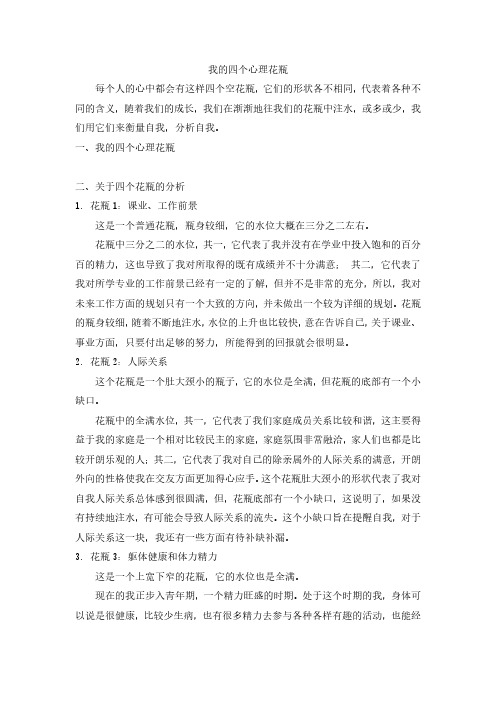
我的四个心理花瓶每个人的心中都会有这样四个空花瓶,它们的形状各不相同,代表着各种不同的含义,随着我们的成长,我们在渐渐地往我们的花瓶中注水,或多或少,我们用它们来衡量自我,分析自我。
一、我的四个心理花瓶二、关于四个花瓶的分析1.花瓶1:课业、工作前景这是一个普通花瓶,瓶身较细,它的水位大概在三分之二左右。
花瓶中三分之二的水位,其一,它代表了我并没有在学业中投入饱和的百分百的精力,这也导致了我对所取得的既有成绩并不十分满意;其二,它代表了我对所学专业的工作前景已经有一定的了解,但并不是非常的充分,所以,我对未来工作方面的规划只有一个大致的方向,并未做出一个较为详细的规划。
花瓶的瓶身较细,随着不断地注水,水位的上升也比较快,意在告诉自己,关于课业、事业方面,只要付出足够的努力,所能得到的回报就会很明显。
2.花瓶2:人际关系这个花瓶是一个肚大颈小的瓶子,它的水位是全满,但花瓶的底部有一个小缺口。
花瓶中的全满水位,其一,它代表了我们家庭成员关系比较和谐,这主要得益于我的家庭是一个相对比较民主的家庭,家庭氛围非常融洽,家人们也都是比较开朗乐观的人;其二,它代表了我对自己的除亲属外的人际关系的满意,开朗外向的性格使我在交友方面更加得心应手。
这个花瓶肚大颈小的形状代表了我对自我人际关系总体感到很圆满,但,花瓶底部有一个小缺口,这说明了,如果没有持续地注水,有可能会导致人际关系的流失。
这个小缺口旨在提醒自我,对于人际关系这一块,我还有一些方面有待补缺补漏。
3.花瓶3:躯体健康和体力精力这是一个上宽下窄的花瓶,它的水位也是全满。
现在的我正步入青年期,一个精力旺盛的时期。
处于这个时期的我,身体可以说是很健康,比较少生病,也有很多精力去参与各种各样有趣的活动,也能经常去参与一些体育锻炼。
全满水位代表了,我自我感觉这个时期的我精力无限。
但,随着时间的快速流逝,我的精力也将会随之流逝。
所以这个上宽下窄的花瓶形状,说明了,水量的减少,水位会先缓慢下降再慢慢加快,也代表了精力会慢慢下降。
hcio4的电离方程式

hcio4的电离方程式
今天,老师讲了一个好难的东西,叫做“hcio4的电离方程式”。
听起来好像很复杂,我有点不太明白。
老师说了一个“hcio4”是什么意思,原来是“高氯酸”!然后呢,还说它在水里可以分成两部分。
我在心里想:“啊,电离方程式是什么呀?”老师看我发愣,就笑了笑,拿起粉笔在黑板上写了一个方程式:“hcio4→h++hcio4-”。
哇,原来“hcio4”就是高氯酸,它分开了,变成了“h+”和“hcio4-”!好像拆开玩具一样,变成了两个小东西。
我拿起铅笔,啪一声,写下了这个方程式,心里咯噔咯噔地想:“嗯,这个不难,我明白了!”然后,我偷偷看了一眼小明,他正嘟着嘴,像是在想事情,好像没听懂呢。
不过,老师说这个电离方程式很重要,可能以后还会用到呢!我也要努力记住,别忘了。
好啦,我得赶紧去做作业啦,咕噜咕噜,笔在本子上转了转,开始写起来啦!
—— 1 —1 —。
冀教版七下英语(带翻译)UNIT4

四单元(19-24)19 a dinner date晚餐聚会Would you like to come over for dinner tomorrow? 明天你想要过来吃晚饭吗?I `m going to be the chess club after school 放学后我要去国际象棋俱乐部I have math class es on Fridays 星期五我要上数学课。
I `m not doing well in math classes this year . 今年我数学学的不好We are going to plant trees. 我们打算去植树We are both busy all week. 我们两个整个星期都很忙碌How about coming over for dinner this evening? 今晚过来吃晚饭怎么样?V ery old people can`t take care of themselves. 年事很高的人不能照顾自己。
They can get help there and meet new friends 在哪里她们可以得到帮助认识新朋友20 join our club加入我们的俱乐部Do you want to improve your thinking skills ? 你想提高你的思维技能吗?Do you want to make new friends ? 你想交新朋友吗?Chess challenges you and makes you think hard 国际象棋挑战你是你开动脑筋Y ou will learn and have fun at the same time. 你将在学习的同时玩的快乐Join us after school on Tuesdays and Tuesdays in Room 288.星期二和星期四放学后去288房间加入我们。
4P、4C、4R的含义与区别,比较实用,也比较全面

1、4P即产品(product)、价格(price)、促销(promoti on)、渠道(place)它的主导是以满足市场需求为目标。
2、4C即消费者(Consume r)、成本(Cost)、便利(Conveni ence)和沟通(Communi cation) 它的主导是以追求顾客满意为目标。
3、4R即关联(Relativ ity)、反应(Reactio n)、关系(Relatio n)和回报(Retribu tion)它的主导是以建立顾客忠诚为目标。
之间的区别从字面上就可以理解了,所追求的达到的目标是不同的,但他们之间有一个逐渐发展的过程,这也是这些大师们从实践中总结出来的,不管是4P、4C还是4R,都是来自于实践,又反过来指导着企业的营销实践。
营销组合(Marketi ng Mix)也称作4P模型,强调了产品、价格、销售渠道和促销手段这四个在销售产品中影响巨大的因素,公司制定产品营销战略时必须对它们加以考虑。
产品 (Product)我的产品与我现有其他产品的关系如何?以确定你的产品之间的协作区域,或发现在哪些方面对各项商业活动有约束。
∙我怎样让自己的产品更出众?个性化(Differe ntiati on)是个大题目,要做到这一点可以通过特点、适宜性、格调、可靠性、包装、服务及品牌命名等方面来体现。
∙产品生命周期对我的计划有什么影响?根据产品在产品生命周期(ProductLife Cycle, PLC)中的不同位置,我们应采取不同的营销策略。
价格 (Price)∙成本定价(Cost Plus):这是最简单的价格策略。
方法是在成本的基础上加上期望的利润。
∙消费者认同价值(Perceiv ed Value to the Consume r):指按照为消费者提供的价值收费。
CTLA-4

CTLA-4细胞毒T淋巴细胞抗原4(CTLA-4)⼜名CD152,是由CTLA-4基因编码的⼀种跨膜蛋⽩质,表达于活化的CD4+和CD8+T细胞。
CTLA-4与其配体B7分⼦结合后产⽣抑制性信号,抑制T细胞激活,使肿瘤细胞免受T淋巴细胞攻击。
因此阻断CTLA-4的免疫效应可刺激免疫细胞⼤量增殖,从⽽诱导或增强抗肿瘤免疫反应。
CTLA-4的结构及功能CTLA-4基因定位于2号染⾊体长臂33带(2q33) ,主要表达于活化的T细胞表⾯,与T细胞表⾯的协同刺激分⼦受体(CD28)具有⾼度的同源性。
CTLA-4和CD28均为免疫球蛋⽩超家族成员,⼆者与相同的配体CD86(B7-2)和CD80(B7-1)结合。
与CD28的功能相反,CTLA-4与B7分⼦结合后抑制T细胞活化。
CTLA-4的作⽤机制尚未完全阐明,认为有以下⼏⽅⾯的可能:①通过其胞外域起竞争配体作⽤:CTLA4与B7分⼦具有⾼度的亲合⼒,与CD28竞争结合抗原提呈细胞(APC)上的B7家族分⼦,阻断CD28与B7的信号传导通路,防⽌CD28分⼦促进T细胞激活(图1)。
②抑制IL-2的产⽣实现负性调节作⽤。
③抑制T细胞从G期进⼊S期,从⽽抑制T细胞的增殖、活化。
④CTLA-4通过与PP2A及SHP2相互作⽤⼲扰TCR信号,同时CTLA-4与PI3K结合,导致AKT磷酸化,引起促凋亡因⼦BAD失活,并上调抗凋亡因⼦Bcl-xL和Bcl-2,在免疫耐受中扮演关键性的⾓⾊。
基于以上理论,CTLA-4为许多疾病包括肿瘤的免疫治疗提供了新的⽅法。
因此发展抗CTLA-4抗体⽤于肿瘤的免疫治疗,是⽬前肿瘤靶向免疫治疗的热点。
CTLA-4单克隆抗体临床前数个⼩⿏动物模型显⽰阻断CTLA-4后肿瘤的控制率提⾼。
由此研发了抗CTLA-4 单克隆抗体。
CTLA-4抗体产⽣的抗肿瘤作⽤包括两种机制:①⼲扰肿瘤特异性效应细胞如CD8细胞,导致其克隆扩增。
②去除肿瘤诱导的调节性T细胞(Treg),Treg细胞可抑制肿瘤相关抗原的免疫反应。
大学英语综合教程2 的课后练习答案unit4
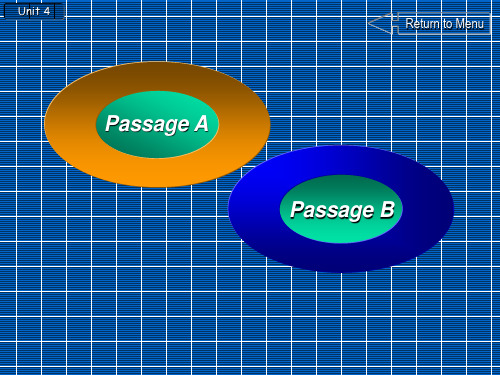
Return to Menu
Passage A
Passage B
Passage A
• Think About It
• Read About It
• Talk About It
• Write About It
1. What kind of people are in favor of carrying on with the cloning science?
Reference:
Most governments prohibit cloning mainly because it is against nature and causes ethical problems. Besides, the failure rate of cloning is very high.
miracle n. — an unusual and mysterious event that cannot be explained by the laws of nature Examples
• The Great Wall is a miracle of architecture.
• A car ran over the child, but by a miracle, he was unhurt.
But only when the science is ready. And that’s the real problem. Five years on from Dolly, the science of cloning is still stuck in the dark ages. The failure rate is a shocking 97 percent and deformed babies all too common. Even when cloning works, nobody understands why. So forget the complex moral arguments. To begin cloning people now, before even the most basic questions have been answered, is simply a waste of time and energy. This is not to say that Antinori will fail, only that if he succeeds it is likely to be at an unacceptably high price. Hundreds of eggs and embryos will be wasted and lots of women will go through difficult pregnancies resulting in miscarriages or abortions. A few years from now techniques will have improved and the wasteful loss won’t be as excessive. But right now there seems to be little anyone can do to keep the cloners at bay.
4字祝福语大全
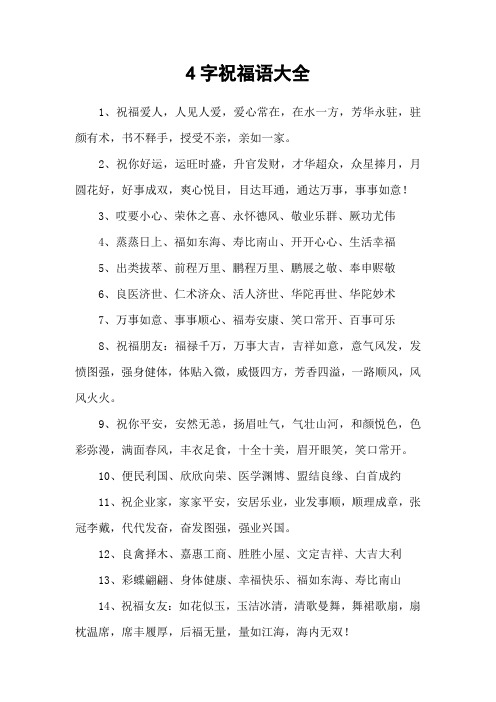
4字祝福语大全1、祝福爱人,人见人爱,爱心常在,在水一方,芳华永驻,驻颜有术,书不释手,授受不亲,亲如一家。
2、祝你好运,运旺时盛,升官发财,才华超众,众星捧月,月圆花好,好事成双,爽心悦目,目达耳通,通达万事,事事如意!3、哎要小心、荣休之喜、永怀德风、敬业乐群、厥功尤伟4、蒸蒸日上、福如东海、寿比南山、开开心心、生活幸福5、出类拔萃、前程万里、鹏程万里、鹏展之敬、奉申赆敬6、良医济世、仁术济众、活人济世、华陀再世、华陀妙术7、万事如意、事事顺心、福寿安康、笑口常开、百事可乐8、祝福朋友:福禄千万,万事大吉,吉祥如意,意气风发,发愤图强,强身健体,体贴入微,威慑四方,芳香四溢,一路顺风,风风火火。
9、祝你平安,安然无恙,扬眉吐气,气壮山河,和颜悦色,色彩弥漫,满面春风,丰衣足食,十全十美,眉开眼笑,笑口常开。
10、便民利国、欣欣向荣、医学渊博、盟结良缘、白首成约11、祝企业家,家家平安,安居乐业,业发事顺,顺理成章,张冠李戴,代代发奋,奋发图强,强业兴国。
12、良禽择木、嘉惠工商、胜胜小屋、文定吉祥、大吉大利13、彩蝶翩翩、身体健康、幸福快乐、福如东海、寿比南山14、祝福女友:如花似玉,玉洁冰清,清歌曼舞,舞裙歌扇,扇枕温席,席丰履厚,后福无量,量如江海,海内无双!15、莺迁乔木、高第莺迁、焕然一新、履新之喜、荣任之喜16、新春快乐、年年有余、蒸蒸日上、身体健康、长命百岁17、祝福恩师:德高望重,众望所归,归之若水,水乳交融,荣华富贵,贵不可言,言文行远,远见卓识,识明智审,神采弈弈!18、蒸蒸日上、日新月异、百年好合、身体健康、龙马精神19、祝福亲人,人人平安,安居乐业,业精于勤,勤以修身,身强体壮,壮气凌云,云程万里!20、勤业永怀、懋绩长留、政绩在民、名标金榜、才高北斗21、祝福朋友:平平安安,安安稳稳,稳稳当当,当家立业,业精于勤,勤慎肃恭,功成名遂,随心所欲,玉树临风,风趣横生,生财有道,道山学海,海波不惊,精气神足!22、你在我心中是最美,美丽动人,人见人爱,爱你久久,久闻大名,名不虚传,传情眉目,目不转睛,金童玉女,女大当嫁,嫁给我吧。
翻译练习4
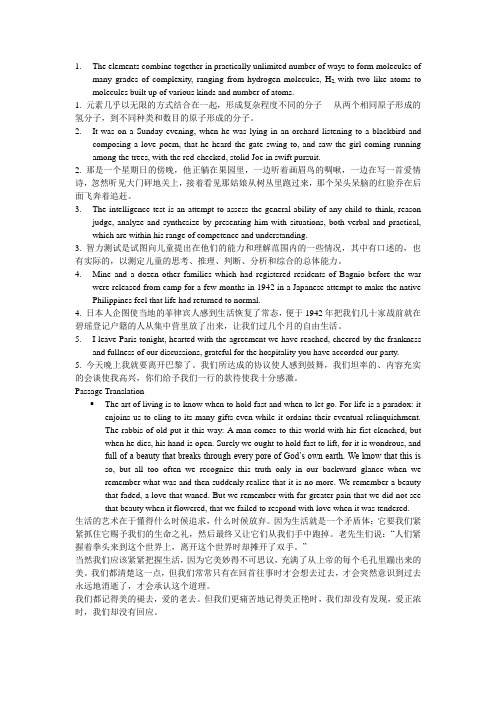
1.The elements combine together in practically unlimited number of ways to form molecules ofmany grades of complexity, ranging from hydrogen molecules, H2, with two like atoms to molecules built up of various kinds and number of atoms.1. 元素几乎以无限的方式结合在一起,形成复杂程度不同的分子----从两个相同原子形成的氢分子,到不同种类和数目的原子形成的分子。
2.It was on a Sunday evening, when he was lying in an orchard listening to a blackbird andcomposing a love poem, that he heard the gate swing to, and saw the girl coming running among the trees, with the red-cheeked, stolid Joe in swift pursuit.2. 那是一个星期日的傍晚,他正躺在果园里,一边听着画眉鸟的啁啾,一边在写一首爱情诗,忽然听见大门砰地关上,接着看见那姑娘从树丛里跑过来,那个呆头呆脑的红脸乔在后面飞奔着追赶。
3.The intelligence test is an attempt to assess the general ability of any child to think, reasonjudge, analyze and synthesize by presenting him with situations, both verbal and practical, which are within his range of competence and understanding.3. 智力测试是试图向儿童提出在他们的能力和理解范围内的一些情况,其中有口述的,也有实际的,以测定儿童的思考、推理、判断、分析和综合的总体能力。
